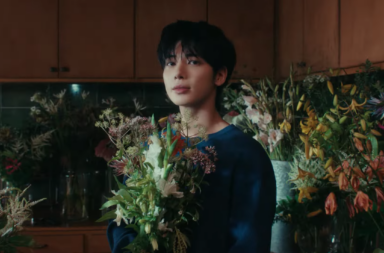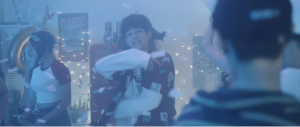 I‘m not too familiar with Samuel Kim, but surely fans of Produce101 are. Around the time where one’s life would ordinarily revolve around petty friend drama, crushes, pop quizzes, and homework, Samuel was busy making a name for himself as an idol, all while (presumably) facing those typical teenage troubles. He was trained under Pledis Entertainment at the ripe age of thirteen, debuted as Punch under the duo OnePunch shortly afterwards, competed in Produce101 as a sixteen-year-old a while later, and attended school at the same time.
I‘m not too familiar with Samuel Kim, but surely fans of Produce101 are. Around the time where one’s life would ordinarily revolve around petty friend drama, crushes, pop quizzes, and homework, Samuel was busy making a name for himself as an idol, all while (presumably) facing those typical teenage troubles. He was trained under Pledis Entertainment at the ripe age of thirteen, debuted as Punch under the duo OnePunch shortly afterwards, competed in Produce101 as a sixteen-year-old a while later, and attended school at the same time.
I’m sure I’m not the only one who wondered what it would be like to live in his shoes as an early teenager. After all, wouldn’t it be interesting to be offered a window into the life of someone whose routine rotates around an epicenter consisting of normal teenage activities combined with a budding professional music career?
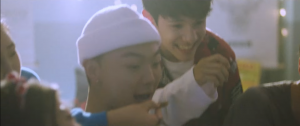
“Sixteen” doesn’t quite offer this window. Far from giving a realistic look at Samuel’s own unique perspective as a teen, it draws a lively depiction of picturesque youthful romance. I’m not really complaining; its not as if I was expecting a detailed account of adolescent angst and idol turmoil from an idol on the cusp of sixteen. In fact, I found the song extremely catchy, albeit corny. Though, I suppose these corny lyrics were intentional; used to add dimension to the naïveté of teenage romance — to showcase the unsullied, idealistic, overly optimistic notion of romance that a great deal of teenagers hold before becoming jaded by further relationship experience:
Sweet 16 16 16
You’re more beautiful than flowers
Changmo contributes the nostalgic, rose-colored introspection of an adult who has lived through his teenage years. In his lines, he adds the perspective of someone meeting his teenage crush as a grown man:
When I first saw you around town
Was when my teacher scolded me for having long hair
But now time has passed and you’re a lady
The content of the lyrics, in addition to the sound design within his verse, provides a nice break within the repetitive structure of the song. During his rapping bit, plucks are utilized instead of the gated synths prevalent throughout the rest of the song.
The MV itself is similarly vivacious, but hones in on positive aspects of teenage life other than romance, such as friendship, freedom, and carefree fun. This is made apparent by montages of Samuel and his squad cavorting around a large supermarket and partying the night away in a homey room. In addition to this, Samuel skateboards across a bridge with city lights twinkling in the backdrop, plays on his phone alone in his bedroom, and competes against a group of guys in a friendly basketball game. It gives off the feeling of “the night is young, and so are we”, which appropriately ties into the themes of youth that the song underlines, even if there is no focus on romance.
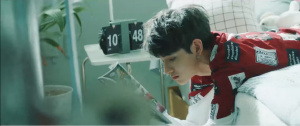
The effect of these shots as a whole is visually appealing. The MV has the vibes of a Tumblr aesthetic blog; the type that is followed almost religiously by many modern-day teens. This is made evident from the interspersed shots of fizzling sparklers, neon signs, and fairy lights in the party room. The the small props dispersed throughout the scenes also further the Tumblr theme, such as the grid-patterned pillows and black and white flip clock on the nightstand in Samuel’s bedroom and the Urban Outfitters-style polaroid that one of the actors use in the party scene. Everything down to Samuel’s hypebeast attire, with his BAPE x Playboy baseball cap and his BAPE collared shirt, is similar to pictures that I have reblogged on Tumblr in the not-so-distant past. As I was a conformist sixteen-year-old only a couple years ago, I can readily attest to the fact that the Tumblr aesthetic largely reflected my artistic sense and much of peers’ as well, so it was suitable for the youth-focused MV and song.
These scenes are all tied together with cool subdued colors, mainly focusing on blue palettes; cyans, periwinkles, navies, deep teals, and sky blues are emphasized in the color grading of the scenes. The usage of fluorescent lighting, overcast skies, and night scenery help bring forth this cool color scheme, while the occasional purplish light leak adds some warmth. The only exception to this subdued palate seem to be the technicolor dance scenes, but even these scenes mostly emphasize blue colors.
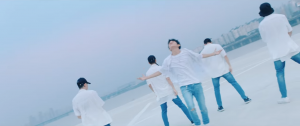 Overall, the emphasis on cool blue tones suit the placidness of the gated synths bestrewed all over the backing instrumental. The tranquility that the blues emphasize also help highlight the pleasant parts of the teenage years showcased throughout the video and the buoyant romance illuminated in the song, or the easy-going joyous times and the happy-go-lucky moments unbowed by worries.
Overall, the emphasis on cool blue tones suit the placidness of the gated synths bestrewed all over the backing instrumental. The tranquility that the blues emphasize also help highlight the pleasant parts of the teenage years showcased throughout the video and the buoyant romance illuminated in the song, or the easy-going joyous times and the happy-go-lucky moments unbowed by worries.
One scene that especially stood out was the one where Samuel was dancing on the white rooftop. The editor likely placed a masking effect on Samuel and the dancers to make their images sharp and clear, while adding a hazy pastel purple/blue gradient over an overexposed cityscape background. This edit created a gorgeous, dream-like dance scene.
Lastly, as for Samuel’s dancing itself, there is something so absolutely enticing about the way he moves. He pulls off the breezy, uptempo choreography with an effortless swagger and cadence that is a sliver reminiscent of Chris Brown. In fact, Samuel’s supermarket dance scene reminded me a bit of Chris’s laundromat one in the MV for his song, “Zero”.
Saccharine lyrics and an MV showcasing excellent cinematography help construct “Sixteen”‘s ideal teenage world — one that invokes reminiscence and blitheness, even if it is corny. Here’s to wishing Samuel a sweet sixteen, and an even better seventeen.
(YouTube, Images via Brave Entertainment)


